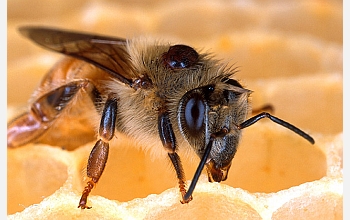News Release 06-157
Newly Discovered Genes, Brain Chemicals Likely Play a Role in Complex Bee Behavior
May lead to better understanding of human behavior

The 1 million neurons in the brain of a honey bee control an array of complex social behaviors.
October 30, 2006
This material is available primarily for archival purposes. Telephone numbers or other contact information may be out of date; please see current contact information at media contacts.
Using a new combination of techniques, U.S. and European scientists have identified 36 genes that encode brain chemicals likely to play a role in the complex behaviors of the honey bee--from working in and defending the hive to foraging, displaying and interpreting dance language. Understanding the jobs these chemicals, called neuropeptides, carry out in the honey bee will help researchers understand what they do in humans, the scientists said.
Some 10,157 genes have so far been identified in the recently sequenced honey bee (Apis mellifera) genome. Jonathan Sweedler at the University of Illinois at Urbana-Champagne and his coworkers in Belgium report in the Oct. 27, 2006, issue of the journal Science they identified 36 honey bee genes that encode 100 neuropeptides. The insect's brain contains 1 million neurons--several of the organs would fit on the head of a pin--which are bathed in neuropeptides that influence the animal's vast array of behaviors.
The group used a new combination of methods that included genetic analysis, powerful computing programs and mass spectrometry to make the discoveries. Determining the gene that encodes a neuropeptide, which is a smallish protein, is harder than in most instances because the protein molecules are often so dramatically modified they no longer show any relationship to their "parent" gene.
Sweedler says his blended technology approach to peptide discovery holds promise for finding the molecules in the large number of genomes of other species currently being sequenced.
The work was funded by the National Science Foundation and the National Institutes of Health.
-NSF-
Media Contacts
James Kloeppel, University of Illinois, (217) 244-1073, email: kloeppel@uiuc.edu
The U.S. National Science Foundation propels the nation forward by advancing fundamental research in all fields of science and engineering. NSF supports research and people by providing facilities, instruments and funding to support their ingenuity and sustain the U.S. as a global leader in research and innovation. With a fiscal year 2023 budget of $9.5 billion, NSF funds reach all 50 states through grants to nearly 2,000 colleges, universities and institutions. Each year, NSF receives more than 40,000 competitive proposals and makes about 11,000 new awards. Those awards include support for cooperative research with industry, Arctic and Antarctic research and operations, and U.S. participation in international scientific efforts.
Connect with us online
NSF website: nsf.gov
NSF News: nsf.gov/news
For News Media: nsf.gov/news/newsroom
Statistics: nsf.gov/statistics/
Awards database: nsf.gov/awardsearch/
Follow us on social
Twitter: twitter.com/NSF
Facebook: facebook.com/US.NSF
Instagram: instagram.com/nsfgov


